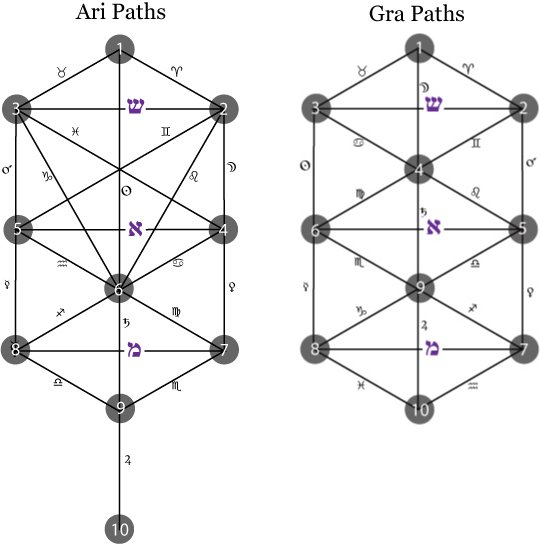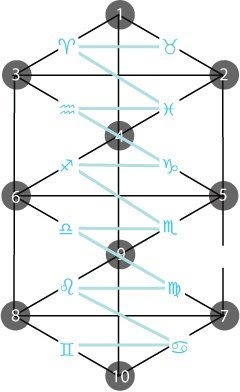Ten Sefirot of Nothingness
And Twenty-Two Foundation Letters
Three Mothers
Seven Doubles
And twelve Elementals
(Sefir Yetzirah, 1:2)
These first words of the Sefer Yetzirah lay the foundation for the entire treatise as contemplation on the mathematical and symbolic relations between the ten Sefirot of creation and the twenty-two letters of the Hebrew alphabet. Together these make up the thirty-two emanated “Paths of Wisdom” by which God creates and orders the universe. As such, they are also to be understood as the paths of re-absorption and mystical ascension towards the source of the Divine.
The three Mothers ( ש ,מ, א) are the first, middle, and penultimate letters of the alphabet , they correspond to the three elements of creation (Ruach/Logos, Philosophic Water, and Philosophic Fire). The seven Doubles ( ת ,ר ,פ , כ ,ד ,ג ,ב) are the seven Hebrew consonants that have a hard and soft pronunciation; they represent the seven planets. The remaining twelve letters are the Elementals ( ה ,ו, ז, ח, ט ,י, ל, נ, ס, ע, ץ, and ק ) attributed to the twelve constellations of the Traditional zodiac... Let us take a moment to point out the obvious; among other things, the seven planets also equate with the days of the week and the constellations with the months in a year.
Thus, when discussing these correspondences we must keep in mind their multi-dimensional nature as symbols of both space and time; and of course, we must not forget that even by taking into account their space-time correspondences we are still limiting our discussion to manifestations of the symbols and not the transcendent principles behind those symbols that exist regardless of space or time.
The twenty-two letters are mapped to the line segments, or paths of the Kabbalistic Tree according to the inherent geometric division of the Tree: three horizontal, seven vertical, and twelve diagonal paths.
The three Mothers govern the three horizontal paths as pictured above. They represent the primordial polarities of Philosophic Fire (ש), and Philosophic Water (מ) separated and joined by the divine 'breath' of Ruach (א). This is a clear metaphor to the act of creation and the Breath of God via the spoken word (Logos) separating the higher waters (ש /🜂) from the lower (מ /🜄).
The seven Doubles map to the seven vertical paths. The most logical order by which to attribute the Doubles to the planets is by order of emanation. Thus: ב= Saturn, ג = Jupiter, ד = Mars, כ = Sun, פ = Venus, ר = Mercury, and ת = Moon. Of course, this is the Traditional ordering of the planets based on their sidereal cycles and astronomical distance from earth (See Classical Planets & Chaldean Order). This is the order in the Short, Long, Saadia, Suares, Donash, and Shiur Komah versions of the Sefer Yetzirah. The Gra and Golden Dawn versions differ significantly and are quite likely influenced by the letter-planet correspondences found in the Zohar. However, this is beyond our present scope.
The various versions of the Sefer Yetzirah attribute each of the twelve Elementals to the twelve constellations in alphabetical and zodiacal order. Since they all begin with Aries, we can be assured that all the surviving versions of the text are not older than the Age of Aries (post 12th Century B.C.E).
Despite their differences all the sources indicate that the patriarch Abraham was the original author of text which is at odds with the system beginning with the constellation of Aries. Due to a slight wobble in the earth’s axis, the zodiacal constellation corresponding to the Vernal Equinox shifts every 2,160 years; an event known as the Precession of the Equinoxes. The historical Biblical period from the time of the patriarchs (Abraham) to the building of the first Temple in Jerusalem would have corresponded to the Age of Taurus, well before the Age of Aries. It is worth noting that during the Age of Taurus, the Cardinal constellations would have been Taurus, Aquarius, Scorpio , and Leo. The traditional imagery of Taurus as a Bull, Aquarius as a Man, Scorpio as an Eagle and Leo as a Lion correspond exactly to the description of the Tetramorphs in Ezekiel’s vision of the Chariot.
Returning to the Sefer Yetzirah, this means one of two things: 1) The astronomical correspondences were either forgotten or never specified in the original text and replaced with the classical Age of Aries zodiac at a later date, or 2) The Sefer Yetzirah is intended as a dynamic living text that must be seen through the lens of a current, past, or future Age. Indeed, it is a worthwhile pursuit to experiment with the different zodiacal correspondences during the various Ages to better grasp the full power of the Tree.
Furthermore, the correspondence systems all maintain that alphabetic order corresponds to spatial order (read clockwise); however, this brings forth questions of multi-dimensionality. If we instead focus on the constellations as symbols of time, the order must be reversed since the sun travels counter-clockwise through the zodiacal belt. This is the Kabbalistic principle of reflection in practice.
Here we will expand upon the Elemental correspondences during the prophetic Age of Taurus as a simple exercise to demonstrate the dynamic nature of the Tree. The letter-constellation pairs would thus be: ה = Taurus , ו = Aries, ז = Pisces, ח = Aquarius, ט = Capricorn , י = Sagittarius, ל = Scorpio , נ = Libra, ס = Virgo, ע= Leo, ץ = Cancer, and ק = Gemini.
The resulting Tree displays the polarities of the Universe balanced by the Central Pillar. The constellations to the left of the Center Pillar all correspond to the active classical elements (Fire and Air), while those to the right to the passive classical elements (Water and Earth). The constellations zigzag from Taurus to Gemini in zodiacal order. The descending order (Taurus to Gemini) follows the Precession of the Equinoxes, while the ascending order (Gemini to Taurus) is the annual progression of the Sun across the zodiac. Whichever way you look at it, the directionality of the zigzag corresponds to the active and passive polarities on the left and right- these polarities being the driving force of creation in the never-ending circuitry of the double helix.
There seems to be an apparent contradiction as the Sefirot of Binah (3) is on the right side corresponding to the active constellations, and Chokmah(2) is on the left with the passive constellations. Traditionaly, Chokmah is attributed to the masculine principle of Wisdom, while Binah is the feminine Understanding. This however is not a contradiction; far from it, in fact this outlines the very principle of Kabbalistic reflection. That which is male/+ reflects towards that which is female/-, this is how the incorporeal Supernal Triad interacts with the material universe. Furthermore, this same principle of reflection is hard-wired into our own neurological circuitry. Our Left Brain controls the muscles and sensations on the Right side of our body, while the Right Brain does the same for the Left side.
Meditate upon this and the biblical narrative of the Serpent coiled around the Tree in the Garden will take a whole new dimension.
Originally Published November 17, 2008 as “Concerning the Tree” in Reflections from the Black Stone





